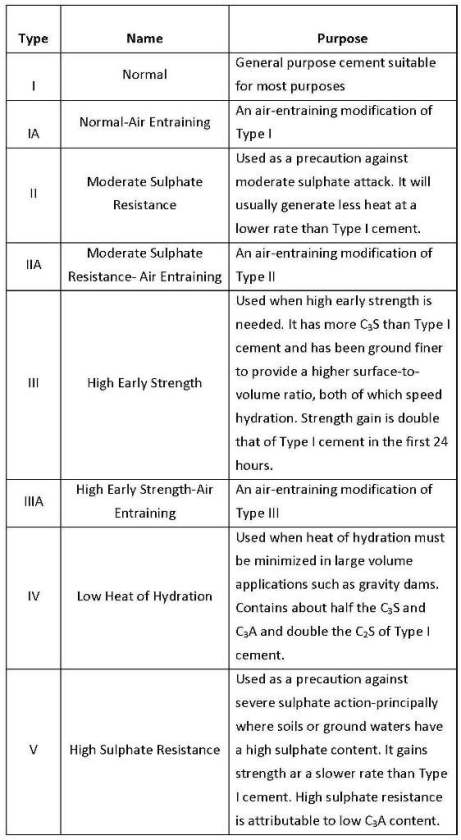
Today (NST)
Friday, Apr 25, 2025
Smart Search
Please post in your Technical Queries, Comments & Suggestions to Contact us......
Advertisement

For Advertisement
|
|
| Subscribe to BREINS Sci-Tech |
| Visit this group |

Concrete Technology
It can be seen from the above reactions that besides the Calcium Silicate Gel (C-S-H), Calcium Hydroxide, Ca(OH)2, is a major by-product of this hydration process. Calcium Silicate Gel (C-S-H) is the binder that produces a firm and hard mass. Hydration of C3S produces a relatively lower
quantity of (C-S-H) gel and more quantity of Calcium
Hydroxide than that produced in the hydration of C2S.
Presence of Ca(OH)2
in concrete is often not desirable especially in hydraulic structures. It is soluble in water
and get leached out creating pores in concrete thereby affecting its durability. However, this process can cause the self-healing of fractures in particular conditions making deposits or efflorescences inside the cracks.
Types of Portland Cement
Type IS (X) - Portland Blast Furnace Slag Cement
Type IP (X) - Portland Pozzolana Cement
Type IT(AX)(BY) - Ternary Blended Cement
Blended Cements are produced by uniformly intergrinding or blending two or more types of fine materials. The primary materials are Portland cement, slag cements, fly ash, silica fume, calcined clay, other pozzolans, hydrated lime, and pre-blended combinations of these materials. Portland Pozzolana Cement, Type IP (X), is discussed in detail next.
Portland Pozzolana Cement (PPC)
It is a kind of Blended Cement which is produced by either intergrinding of OPC clinker along with gypsum and Pozzolanic materials (Pozzolanas) in certain proportions or grinding the OPC clinker, gypsum and Pozzolanas separately and thoroughly blending them in certain proportions.
Pozzolana is a natural or artificial siliceous material in a reactive form. It may be further discussed as siliceous and aluminous material which itself possesses little, or no cementitious properties but will in finely divided form and in the presence of moisture, chemically react with Calcium Hydroxide, Ca(OH)2, (the unwanted by-product of cement hydration) at ordinary temperature to form compounds possessing cementitious properties, C-S-H gel. Following Pozzolanic reaction takes place;
Pozzolanic reaction stands a simple acid-base reaction between Ca(OH)2, and Silicic Acid, H4SiO4 or Si(OH)4. Simply, this reaction can be schematically represented as follows:
Ca(OH)2 + H4SiO4 → CaH2SiO4.2H2O; or simply
Ca(OH)2+ Pozzolana + Water → C-S-H (Cement Gel)
It is essential that Pozzolana be in a finely divided state as it is only then that silica can combine with calcium hydroxide liberated by the hydrating Portland Cement in the presence of water to form stable calcium silicates which have cementitious properties. The natural and artificial pozzolanic materials commonly used are:
Fly Ash
Volcanic Ash
Calcined Clay
Silica Fumes
An unique characteristic of natural pozzolanas is its inherent ability to actually heal or re-cement cracks within the concrete by means of the continuation of pozzolanic reaction with the calcium hydroxide freed from the cement hydration reaction. This results in the filling up of most of the gaps inside the hardened concrete matrix.
The most commonly used Pozzolana in production of Portland Pozzolana Cement, PPC, is Fly ash; an Artificial Pozzolana, which is by-product of coal burning thermal power plants. In PPC, quantity of Fly Ash varies from 10-40% and is usually around 20 %.
PPC offers lesser heat of hydration with slower rate of gain of strength especially in early days; up-to 7 days. Use of Pozzolanas in PPC in no-way contribute in gain of strength at early days. Reactions usually continue for longer time period at the slower rate, thus need more curing time while using PPC for concreting works. Also, PPC is expected to gain the strength equivalent to 28 days strength of OPC only at later ages; almost at 40 - 50 days after casting. But it all depends on the amount of Fly Ash used in the manufacture of PPC.
Why Portland Pozzolana Cement, PPC, is desirable ??
Portland Pozzolana Cement, PPC, of course offers some superior properties to that of Ordinary Portland Cement, OPC; provided that the Pozzolanas used in the production of such PPC are in right quantities and of good quality; a reactive one.
Use of PPC in making concrete is highly desirable from durability point of view because of its Pozzolanic action. In due course of time, It produces a more durable and hence stronger concrete than OPC. PPC is highly desirable in concrete structures that remain in contact with water and in marine/coastal and humid environments.
Hydration of Cement produces a large amount of free Calcium Hydroxie, Ca(OH)2 as seen from the reactions above. Presence of free Calcium Hydroxide, Ca(OH)2, in hardened concrete is undesirable as it could badly affect the durability of concrete especially in hydraulic and marine structures. It reacts with water leading to the leaching action thereby forming the voids in concrete. Also, Ca(OH)2 reacts with Sulphates present in soils leading to Sulphate Attack that often happens in foundation concrete.
All these undesirable effects of Calcium Hydroxide in hardened concrete can be highly minimized by use of Portland Pozzolana Cement, PPC, that consumes this Ca(OH)2 thereby converting it into C-S-H gel that densifies the hardened concrete. Densification process makes concrete more impermeable; hence durable one, in due course of time.
Advantages & Uses of Portland Pozzolana Cement
Less Heat of Hydration : Makes it suitable for mass concreting work and hot weather concreting work.
Higher Resistance Against Aggressive Water Conditions : Makes it suitable for marine and under water concrete structures.
Higher Resistance Against Sulphate Attack : Makes it suitable for adverse conditioned concrete structures.
Economical : Costly cementious clinker is replaced up-to 40% by cheaper Fly Ash; the power plant waste.
Properties of PPC in Comparision to OPC
Low Early Strength
Generates Lesser Heat of Hydration
Requires Increased Curing Time (about 20-30% more than OPC)
Improves Mix Workability
Reacts less with Sulphates and Salts
Produces more Impermeable Concrete
Provides better protection againt Aggressive Environments
It should be noted that PPC can be used in all the situations where OPC is used except in the cases where strength at early days similar to that of OPC is needed for quick formwork removal or due to other reasons. Otherwise at later ages, in long term, PPC produces far better durable concrete with probably little enhancement in strength to that of the OPC.
Fineness of Cement
Fineness of Cement is a measure of its specific surface area; that is
the total surface area of cement in a given weight of cement. Generally
it is measured in m2/Kg. The smaller the particle size, the
greater the surface area-to-volume ratio, and thus, the more area available
for water-cement interaction per unit volume. The number of the particles
of cement powder in a unit weight also reflects the fineness of cement.
The development of strength of cement is proportional to the fineness of the cement. The effects of greater fineness on strength are generally seen during the first seven days.
Fineness of cement is tested in two ways:
a) By sieving
b) By determination of specific surface by Blaine air permeability apparatus.
IS 269-1989, IS 8112-1989 & IS 12269-1987 require minimum value of fineness as 225m2/Kg for OPC and IS 1489-1991 requires a minimum fineness of PPC as 300m2/Kg.
Soundness of Cement
Soundness of cement refers to the ability of cement paste to retain
its volume after setting without delayed destructive expansion. This
destructive expansion is caused by excessive amounts of free lime (Cao)
or Magnesia (Mgo). Certain cements have been found to undergo a large
expansion after setting causing disruption of the set and hardened mass.
This will cause serious difficulties for durability of structures when
such cement is used.
The standard autoclave expansion test is performed to detect unsoundness in cement.
Setting of Cement
Setting time refers to the time required to stiffening of cement paste.
It’s a time required for a cement paste to change from a fluid to rigid
stage. Normally two setting times are defined: initial setting time
and final setting time.
Initial setting time is regarded as the time elapsed between the moments that the water is added to the cement, to the time that the paste starts losing its plasticity. The final setting time is the time elapsed between the moment the water is added to the cement, and the time when the paste has completely lost its plasticity and has attained sufficient firmness to resist definite pressure.
Initial setting time has its significance while mixing, transporting, placing, compacting and finishing process. Certain time is required during these processes. So the Initial setting time of cement, cement paste or concrete should not be less than certain specified value. Normally a minimum of 30 minutes is given for mixing and handling operations. Also, once the concrete is placed in the final position, it should lose its plasticity in the earliest possible time so that it is least vulnerable to damages from external destructive agencies. This time should not be more than 10 hours; which is in fact a final setting time.
Vicat needle and Gillmore needle apparatus is used to test define these setting times in which a needle of particular size and weight either penetrates a cement paste to a given depth or fails to penetrate a cement paste sample.
ASTM C 150 has specified following setting times by test method:

